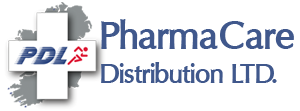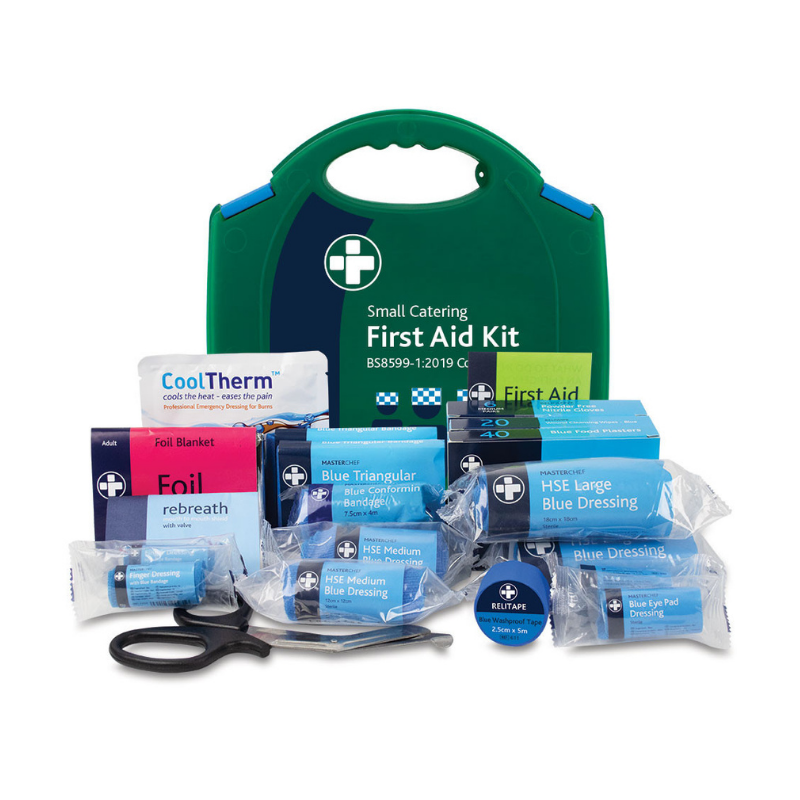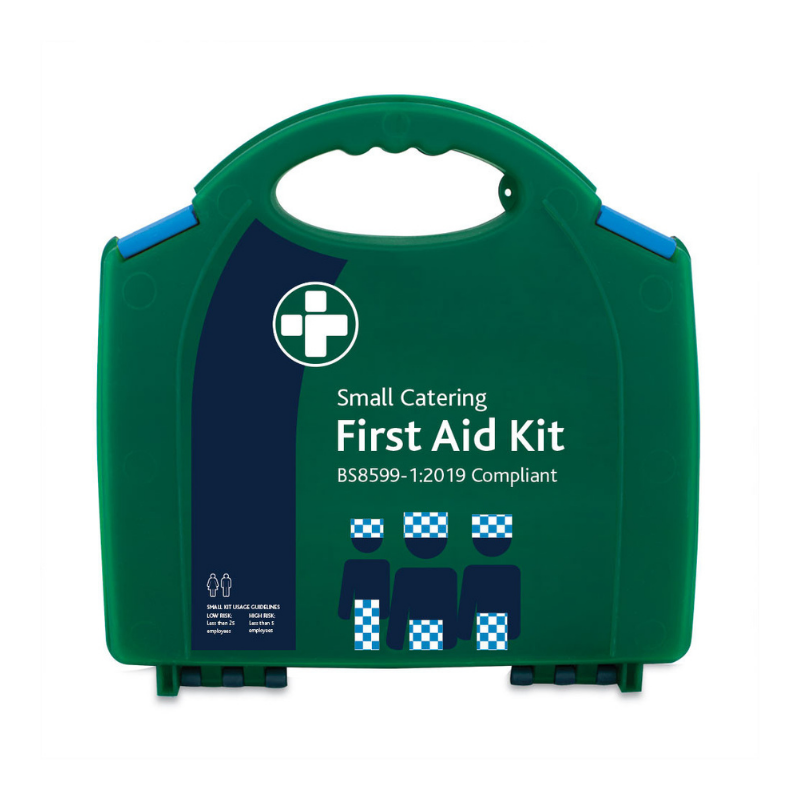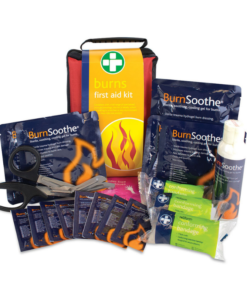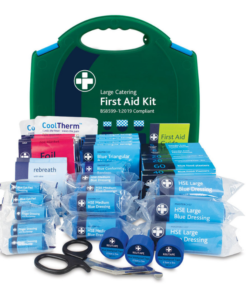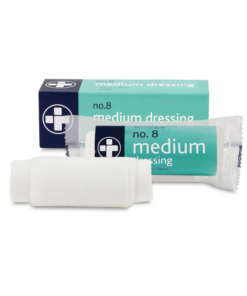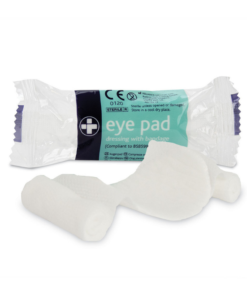Description
Description
For many years, it has been a legal requirement to use only blue detectable plasters in food preparation areas. This Catering First Aid Kit goes above and beyond requirements by providing you for the first time with a kit where every single product, even the dressings and wipes, are all blue. With this kit in your workplace, there is no better way to demonstrate to the authorities that you are taking your responsibilities seriously. The kit comes in a stylish colour-coded carry case and complies with food hygiene regulations. The Catering First Aid Kit in the small size can be used as a low risk 1 kit for 1-25 employees, or a high risk 1 kit for 1-5 employees.
The Catering First Aid Kit contains:
- 1 x Small Integral Aura Box
- 1 x CoolTherm Burn Relief Dressing – 10cm x 10cm
- 40 x Dependaplast Blue Detectable Plasters – Assorted
- 2 x Sterile Eye Pad Dressing (Blue with Bandage)
- 1 x Adult Size Foil Blanket – 130cm x 210cm
- 2 x Large Blue Sterile HSE Dressing – 18cm x 18cm
- 2 x Medium Blue Sterile HSE Dressing – 12cm x 12cm
- 6 x Pair of Nitrile Gloves
- 1 x Rebreath Resuscitation Device (with valve)
- 2 x No 7 Blue Finger Dressing
- 1 x Reliform Conforming Bandage – 7.5cm x 4m
- 20 x Reliwipe Blue Saline Wipes
- 2 x Blue Triangular Bandages (Single Use) – 90 x 127cm
- 1 x 6” Universal Shears
- 1 x First Aid Guidance Leaflet
- 1 x Relitape Washproof Blue Tape – 2.5cm x 5m
All medical devices in the Catering First Aid Kit are CE marked.
Size: 22.5cm x 23cm x 9.5cm
Uses
The Catering First Aid Kit can be used in a workplace catering environment. The risk assessment should be determined by the number of people on site and the category of hazard they are exposed to. Low risk establishments may include shops, offices, libraries etc and high risk establishments may include light engineering and assembly work, food processing, warehousing, etc.
Application
What to do in an emergency
Priorities:
• Assess the situation – do not put yourself in danger
• Make the area safe
• Assess all casualties and attend any unconscious casualties first
• Send for help – do not delay
Check for a response:
• Gently shake the casualty’s shoulders and ask loudly: Are you all right?
• If there is no response, your priorities are to:
o Shout for help
o Open the airway
o Check for normal bleeding
o Take appropriate action
Follow the A, B, C’s:
A: Airway
• To open the airway, place your hand on the casualty’s forehead and gently tilt the head back
• Lift the chin with two fingertips
B: Breathing
• Look, listen and feel for normal breathing for no more than 10 seconds:
o Look for chest movement
o Listen at the casualty’s mouth for breath sounds
o Feel for air on your cheek
• If the casualty is breathing normally:
o Place in the recovery position
o Get help
o Check for continued breathing
• If the casualty is not breathing normally:
o Get help and call for an AED if available
o Start chest compressions
C: CPR
• To start chest compressions, lean over the casualty and with your arms straight, press down on the centre of the breastbone 5 – 6cm, then release the pressure
• Repeat at a rate of 100 – 120 times a minute
• After 30 compressions, open the airway again
• If an AED is available, use in accordance with your training / manufacturer’s instructions
• Pinch the casualty’s nose closed and allow the mouth to open
• Take a normal breath and place your mouth around the casualty’s mouth, making a good seal
• Blow steadily into the mouth while watching for chest rising
• Remove your mouth from the casualty and watch for the chest falling
• Give a second breath and then start 30 compressions again without delay
• Continue with chest compressions and rescue breaths in a ration of 30:2 until qualified help takes over or the casualty starts breathing normally
Severe Bleeding:
• Apply direct pressure to the wound
• Raise and support the injured part (unless broken)
• Apply a dressing and bandage firmly in place
Broken Bones and Spinal Injuries:
• If a broken bone or spinal injury is suspected, obtain expert help
• Do not move casualties unless they are in immediate danger
Burns:
• Burns can be serious, so if in doubt seek medical help
• Cool the affected part of the body with cold water until the pain is relieved
• Thorough cooling may take 10 minutes or more, but this must not delay taking the casualty to hospital
• Certain chemicals may seriously irritate or damage the skin. Avoid contaminating yourself with the chemical. Treat in the same way as for other burns but flood the affected area with water for 20 minutes. Continue treatment even in the way to the hospital, if necessary. Remove any contaminated clothing which is not stuck to the skin, using scissors if necessary.
Eye Injuries:
• All eye injuries are potentially serious
• If there is something in the eye, wash out the eye with clean water or sterile fluid from a sealed container to remove loose material
• Do not attempt to remove anything that is embedded in the eye
• If chemicals are involved, flush the eye with water or sterile fluid for at least 10 minutes, while gently holding the eyelids open. Ask the casualty to hold a pad over the injured eye and send them to the hospital
Record Keeping:
• It is good practice to use a book for recording any incidents involving injuries or illness which you have attended. Include the following information in your entry:
o The date, time and place of the incident
o The name and job of the injured or ill person
o Details of the injury / illness and any first aid given
o What happened to the casualty immediately afterwards (e.g. went back to work, went home, went to hospital)
o The name and signature of the person dealing with the incident
• This information can help identify accident trends and possible areas for improvement in the control of health and safety risks
